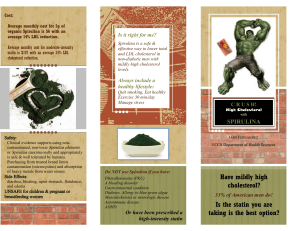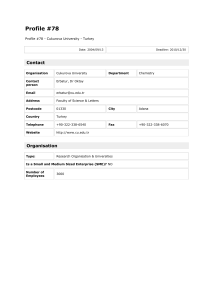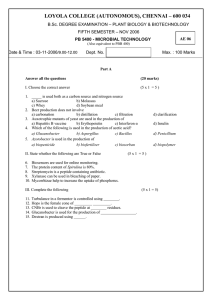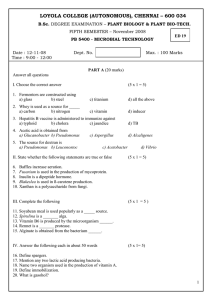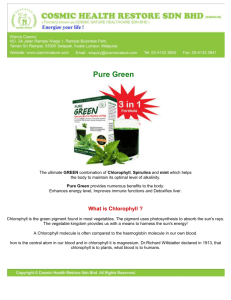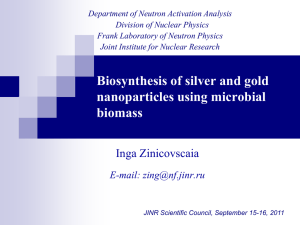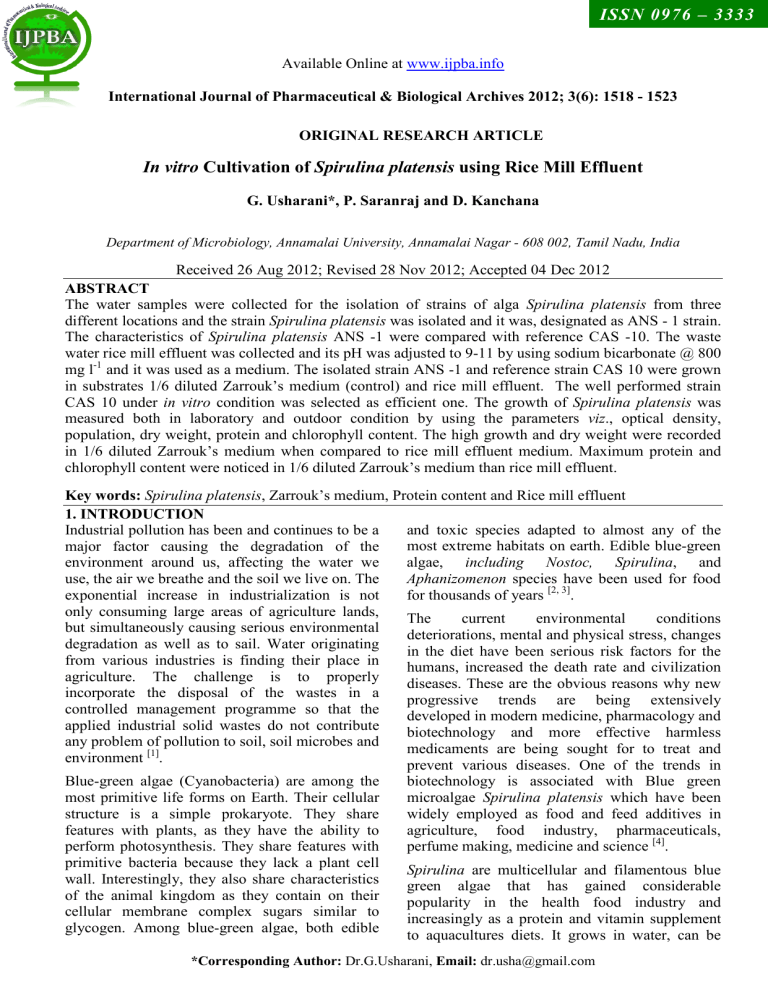
ISSN 0976 – 3333
Available Online at www.ijpba.info
International Journal of Pharmaceutical & Biological Archives 2012; 3(6): 1518 - 1523
ORIGINAL RESEARCH ARTICLE
In vitro Cultivation of Spirulina platensis using Rice Mill Effluent
G. Usharani*, P. Saranraj and D. Kanchana
Department of Microbiology, Annamalai University, Annamalai Nagar - 608 002, Tamil Nadu, India
Received 26 Aug 2012; Revised 28 Nov 2012; Accepted 04 Dec 2012
ABSTRACT
The water samples were collected for the isolation of strains of alga Spirulina platensis from three
different locations and the strain Spirulina platensis was isolated and it was, designated as ANS - 1 strain.
The characteristics of Spirulina platensis ANS -1 were compared with reference CAS -10. The waste
water rice mill effluent was collected and its pH was adjusted to 9-11 by using sodium bicarbonate @ 800
mg l-1 and it was used as a medium. The isolated strain ANS -1 and reference strain CAS 10 were grown
in substrates 1/6 diluted Zarrouk’s medium (control) and rice mill effluent. The well performed strain
CAS 10 under in vitro condition was selected as efficient one. The growth of Spirulina platensis was
measured both in laboratory and outdoor condition by using the parameters viz., optical density,
population, dry weight, protein and chlorophyll content. The high growth and dry weight were recorded
in 1/6 diluted Zarrouk’s medium when compared to rice mill effluent medium. Maximum protein and
chlorophyll content were noticed in 1/6 diluted Zarrouk’s medium than rice mill effluent.
Key words: Spirulina platensis, Zarrouk’s medium, Protein content and Rice mill effluent
1. INTRODUCTION
Industrial pollution has been and continues to be a
and toxic species adapted to almost any of the
most extreme habitats on earth. Edible blue-green
major factor causing the degradation of the
algae, including Nostoc, Spirulina, and
environment around us, affecting the water we
use, the air we breathe and the soil we live on. The
Aphanizomenon species have been used for food
for thousands of years [2, 3].
exponential increase in industrialization is not
only consuming large areas of agriculture lands,
The
current
environmental
conditions
but simultaneously causing serious environmental
deteriorations, mental and physical stress, changes
degradation as well as to sail. Water originating
in the diet have been serious risk factors for the
from various industries is finding their place in
humans, increased the death rate and civilization
agriculture. The challenge is to properly
diseases. These are the obvious reasons why new
incorporate the disposal of the wastes in a
progressive trends are being extensively
controlled management programme so that the
developed in modern medicine, pharmacology and
applied industrial solid wastes do not contribute
biotechnology and more effective harmless
any problem of pollution to soil, soil microbes and
medicaments are being sought for to treat and
environment [1].
prevent various diseases. One of the trends in
Blue-green algae (Cyanobacteria) are among the
biotechnology is associated with Blue green
most primitive life forms on Earth. Their cellular
microalgae Spirulina platensis which have been
structure is a simple prokaryote. They share
widely employed as food and feed additives in
features with plants, as they have the ability to
agriculture, food industry, pharmaceuticals,
perform photosynthesis. They share features with
perfume making, medicine and science [4].
primitive bacteria because they lack a plant cell
Spirulina are multicellular and filamentous blue
wall. Interestingly, they also share characteristics
green algae that has gained considerable
of the animal kingdom as they contain on their
popularity in the health food industry and
cellular membrane complex sugars similar to
increasingly as a protein and vitamin supplement
glycogen. Among blue-green algae, both edible
to aquacultures diets. It grows in water, can be
*Corresponding Author: Dr.G.Usharani, Email: dr.usha@gmail.com
Usharani et al / In vitro cultivation of Spirulina platensis using Rice mill effluent
IJPBA, Nov - Dec, 2012, Vol. 3, Issue, 6
harvested and processed easily and has very high
macro and micro nutrient contents. It has long
been used as a dietary supplement by people
living close to the alkaline lakes where it is
naturally found for instance those living adjacent
to lake chad in the kanem region have very low
levels of malnutrition despite living on a Spartan
millet base diet. This traditional food, known as
dihe, was rediscovered in chad by a European
scientific mission and is now widely cultured
throughout the world. In many countries of Africa,
it is still used as human food as a major source of
protein and is collected from natural water, dried
and eaten. It has gained considerable popularity in
the human health food industry and in a many
countries of Asia, it is used as protein supplement
and as health food [3].
The mass cultivation of Spirulina is achieved both
in fresh water and waste water. Spirulina grown in
clean waters and under strictly controlled
conditions could be used for human nutrition. The
micro alga grown in waste water is used as animal
feed and provide a source of the fine chemicals
and fuels. The waste water system is highly
applicable in populated countries like India where
wastes are generated in high quantities and pose
environmental problem. Large scale production of
Spirulina is feasible in tropical conditions in
developing countries, where land costs and labour
are comparatively cheaper. The microalga can be
exploited as a potential source of food, feed and
fuel [5].
2. MATERIALS AND METHODS
2.1. Isolation and purification of Spirulina
platensis
Individual colonies from the enrichment culture
flasks were lifted with the help of an inoculation
needle and suspended in 5 ml of distilled water in
test tubes. The tubes were uniformly shaken
manually to make a homogenous suspension. 0.5
ml of this suspension was inoculated into 50 ml
sterile Zarrouk’s medium in 100 ml Erlenmeyer
flask. The inoculated flasks were incubated; the
isolated colonies were picked up and examined
under compound microscope. Among the water
collected from three different locations, there was
algal growth only in the sample from Annamalai
Nagar temple pond in Zarrouk’s medium. The
isolated strain was purified and designated as
ANS1 (Annamalai Nagar Spirulina 1). The
isolated strain (ANS -1) was compared with
reference strain (CAS-10) for its characters.
2.2. Cultivation of Spirulina platensis in
Zarrouk’s medium under laboratory condition
The pure culture of algal strains ANS-1, CAS-10
were grown in Zarrouk’s medium and used as the
standardized inoculum for comparing their growth
rate. The standardized inoculum was measuring
0.91 optical density at 320nm and used in the
growth studies to measure various growth
parameters. The standardized inoculum 5ml was
inoculated in to 50ml Zarrouk’s medium in 100ml
Erlenmeyer flasks and incubated for 21 days in
light chamber. Growth of spirulina platensis two
strains were measured through optical density,
population, dry weight, protein and chlorophyll
content to select the better stains for mass
production.
2.3. Collection of Rice mill effluent
Rice mill effluent was collected from Ambiga
Rice mill, Annamalai Nagar and used for the
growth of Spirulina platensis strains. The
following were the characteristics of Rice mill
effluent.
2.4. In vitro cultivation of Spirulina platensis
using Rice mill effluent
The Spirulina platensis strain CAS-10, ANS-1
were grown under laboratory condition in various
substrates viz., 1/6 diluted Zarrouk’s medium and
Agro industrial effluent viz., Rice mill effluent
medium and sago industrial effluent. The 1/6
diluted Zarrouk’s medium was used as a standard
medium to compare the growth. 40 ml of
standardized algal inoculum was inoculated into
400 ml of the various substrates in 500 ml
Erlenmeyer flasks separately. After inoculation,
the substrates in 500 ml Erlenmeyer flasks were
incubated under illuminated light chamber (3 to 4
k lux light intensity) at 28 ± 2°C temperature for
21 days. Three replications were maintained for
each medium.
2.5. Estimation of growth parameters in
Spirulina platensis
The growth parameters of Spirulina platensis
strains ANS 1 and CAS 10 in various media were
measured at three different periods (7th, 14th, 21st
day).
2.5.1. Optical density
Optical densities (O.D) of the algal strains were
measured in spectrophotometer (Spectronic 1001).
The O.D value was observed at different
wavelength (300 to 650 nm) and the higher O.D
values were recorded at 320 nm wavelength.
Hence, the growth of Spirulina platensis strains
1519
© 2010, IJPBA. All Rights Reserved.
IJPBA, Nov - Dec, 2012, Vol. 3, Issue, 6
Usharani et al / In vitro cultivation of Spirulina platensis using Rice mill effluent
was measured at 320 nm wavelength after the
incubation days.
2.5.2. Population estimation
The population was estimated by direct
microscopic count method. 0.1 ml of the culture
was taken and spread over the marked 1 sq. cm
area of the clean glass slide. Then it was observed
under compound microscope after covering with
cover glass. Numbers of cells were counted per
microscopic field and the populations were
estimated by using conn’s direct microscopic
count method.
2.5.3. Dry weight estimation
The dry weights of the strains were estimated in
standard bottle. 50 ml of the cultures was taken
and centrifuged at 6000 rpm in the centrifuge. The
cell debris obtained was transferred to standard
bottles (known weight), air dried and kept in hot
air oven at 60°C to a constant weight. Then it was
cooled in desiccators and weighed. The difference
in weight (culture bottle–empty bottle) was
expressed as dry weight in mg.
2.5.4. Protein estimation
The protein content of Spirulina platensis cultures
were estimated by the Lowry’s method [6].
2.5.5. Chlorophyll estimation
One gram of Spirulina platensis was homogenized
in 20 ml acetone (80%) and allowed to stand
overnight in dark at 4EC for complete extract
followed by centrifugation at 10,000 rpm for 5
minutes. The contents of total chlorophyll (TChl), chlorophyll a (Chl-a) and chlorophyll b
(Chl-b) in the supernatant were determined
spectophotometrically according to Lichtenthaler
[7]
method.
2.6. Statistical analysis
The experimental data were analysed as per the
procedure suggested by Panse and Sukhatme [8].
3. RESULTS AND DISCUSSION
Cyanobacteria
are
the
photoautotrophic
microorganisms largely distributed in various
aquatic environments. Some of them have been
used as human food for many years because of
their high protein content (35-65 per cent) and
nutritional value. Spirulina is the best known
genus and it was consumed by the Aztecs in
Mexico valley and by the Chand lake population
in Africa. At present some countries including
Argentina are culturing it on a large scale.
Spirulina is beneficial to health due to the
presence of compounds like essential amino acids,
vitamins, natural pigments and essential fatty
acids.
The
genus
Spirulina
belongs
to
the
Oscillatoriaceae family contains the group of
filamentous Cyanobacteria characterized by spiral
shaped chains of cells enclosed in a thin sheath. In
the present investigation, the isolate was identified
based on the microscopic and cultural studies. The
isolated Spirulina platensis strain ANS -1
resembled the characters of the reference strain
CAS 10. The strains were characterized based on
the parameters viz., average number of spirals,
distance between spirals, length, width of
trichome, percent of long and short trichome. The
characteristics of the two strains CAS 10, and
ANS -1 were similar to the characters reported by
Deore [9], Gupta and Chagwal [10] who carried out
observations in Spirulina gigantean var schmidle
and Arthrospira platensis.
The characters of Spirulina platensis strain ANS-1
were compared with the reference strain CAS-10
and the results are presented in Table - 1.
Morphologically they were found to be similar,
multicellular, filamentous, unbranched and
helicoidal trichomes. The characters measured
were spiral number, distance between spirals,
length and width of trichome, number of long
trichome and short trichome. The Spirulina
platensis strain CAS-10 and ANS-1 were
preserved as calcium alginate beads for 60 days
and their viability was tested by estimating the
population per ml on 30th and 60th days after beads
formations. The viable cell populations are
presented in (Fig 1).
Spirulina requires a medium of high alkalinity
with pH values not less than 8.5 and a steady
supply of bicarbonate ions (Ciferri, 1983). In the
present investigation, the Spirulina platensis
strains CAS - 10 and ANS -1 were grown in
Zarrouk’s medium and the growth was analyzed
based on the parameters like optical density,
population, dry weight, protein and chlorophyll
content. All the growth parameters were high in
CAS - 10.
The growth of Spirulina platensis strains CAS -10
and ANS -1 was estimated in Zarrouk’s medium
under laboratory condition through various
parameters like optical density. Cell population
per ml, dry weight, protein and chlorophyll
content and the data are presented in Table - 2.
The various growth parameters viz., optical
density (O.D), cell population per ml, dry weight,
1520
© 2010, IJPBA. All Rights Reserved.
Usharani et al / In vitro cultivation of Spirulina platensis using Rice mill effluent
[14]
, and Po Chung et al. [15] on using diluted media
for SCP production.
protein and chlorophyll content were higher in the
Spirulina platensis strain CAS -10 compared to
ANS -1.
Table 1: Comparison of the characters of Spirulina platensis strains
S. No
Characters
CAS-10
ANS-1
IJPBA, Nov - Dec, 2012, Vol. 3, Issue, 6
The Spirulina platensis strains CAS-10 and ANS1 were grown under laboratory condition i.e., rice
mill effluent with 1/6 diluted in Zarrouk’s
medium. The growth was observed through the
parameters viz., optical density, cell population,
dry weight, protein and chlorophyll content. The
growth of Spirulina platensis strains CAS -10 and
ANS -1 under laboratory condition was recorded
by estimating O.D value on 7th, 14th, 21st day of
growth and the data are furnished in Table - 3.
The growth of both the algal strains was higher in
1/6 diluted Zarrouk’s medium compared to other
substrates.
1
2
3
4
5
Average number of spirals
Distance between spirals
Width of trichome
Length of trichome
Number of short trichomes
3-4
45-50 µm
12.0 µm
260 µm
27 per cent
2-3
45-50 µm
11 µm
250 µm
24 per cent
6
Number of long trichomes
66 per cent
58 per cent
Cell population ml-1
Fig 1: Survival of Spirulina platensis strains in calcium alginate beads
The growth of Spirulina platensis strains CAS -10
and ANS -1 in rice mill effluent under laboratory
condition was recorded by estimating cell
population, dry weight, protein content and
chlorophyll content on 7th, 14th, 21st day of growth
and the data presented in Table – 4 to Table - 7.
The growth parameters, protein content and
chlorophyll content of Spirulina platensis were
maximum in the Zarrouk’s medium when
compared to rice mill effluent. This study is in
line with the earlier findings of Clement et al. [11],
Venkatraman [12], AnusyaDevi et al. [13], Tasneem
1.5
1.45
1.4
1.35
1.3
1.25
1.2
30th day
60th day
CAS -10
ANS -1
Strains of Spirulina platensis
Table 2: Growth parameters of Spirulina platensis under laboratory
condition in Zarrouk’s medium
Spirulina platensis strain
S. No
Growth parameters
CAS -10
ANS -1
1
O.D (at 320nm)
2.305
2.256
2
Cell population/ml
1.5 × 104
1.3 × 104
3
Dry weight (mg-1)
30
25
4
Protein (mg-1)
22
17.5
5
Chlorophyll (mg-1)
14
11
Table 3: Growth pattern of Spirulina platensis under laboratory condition
O.D value at 320 nm
S. No
1
2
Substrate
7th day
CAS -10
14th day
21st day
7th day
ANS -1
14th day
21st day
Zarrouk’s medium
Rice mill effluent medium
SED
2.375
1.635
0.0042
2.426
1.726
0.1114
2.586
1.814
0.0040
1.875
1.062
0.0023
2.135
1.193
0.0012
2.204
1.313
0.0032
CD (p=0.05)
0.0084
0.0238
0.0080
0.0046
0.0025
0.0064
Table 4: Cell population of Spirulina platensis under laboratory condition
Cell population ml-1
S. No
CAS -10
Substrate
th
th
7 day
14 day
4
1.44 × 10
ANS -1
st
th
21 day
4
1.52 × 10
14th day
7 day
4
1.30 × 10
4
1.32 × 10
21st day
4
1.41 × 104
1
Zarrouk’s medium
1.35 × 10
2
Rice mill effluent medium
1.13 × 104
1.10 × 104
1.16 × 104
1.08 × 104
1.03 × 104
1.16 × 104
SED
135.26
127.62
42.82
20.32
25.62
72.48
CD (p=0.05)
270.52
255.24
84.74
40.64
51.24
154.87
Table 5: Dry weight of Spirulina platensis under laboratory condition
Dry weight mgl-1d-1
S. No
CAS -10
Substrate
1
1/6 diluted Zarrouk’s medium
2
Rice mill effluent medium
SED
CD (p=0.05)
ANS -1
7th day
14th day
21st day
7th day
14th day
21st day
19
15
0.421
0.8426
23
19
0.3921
0.7244
27
22
0.5326
0.1652
18
17
0.3523
0.7046
22
18
0.4260
0.8520
26
20
0.3436
0.7973
1521
© 2010, IJPBA. All Rights Reserved.
Usharani et al / In vitro cultivation of Spirulina platensis using Rice mill effluent
Table 6: Protein content of Spirulina platensis under laboratory condition
Protein content ml-1d-1
S. No
1
2
Substrate
1/6 diluted Zarrouk’s medium
Rice mill effluent medium
SED
CD (p=0.05)
7th day
12
8.5
CAS – 10
14th day
15
11
21st day
17
13
7th day
10
9
ANS – 1
14th day
15.5
12.5
21st day
17.5
13
0.2013
0.416
0.2201
0.4412
0.2432
0.4874
0.1022
0.2144
0.1425
0.2850
0.1894
0.3788
Table 7: Chlorophyll content of Spirulina platensis under laboratory condition
Chlorophyll content ml-1d-1
S. No
Substrate
CAS -10
IJPBA, Nov - Dec, 2012, Vol. 3, Issue, 6
7th day
14th day
ANS -1
21st day
7th day
14th day
21st day
1
1/6 diluted Zarrouk’s medium
8.79
9.15
9.82
8.24
8.95
9.20
2
Rice mill effluent medium
7.86
8.31
8.91
7.19
8.00
8.56
SED
0.0409
0.067
0.0775
0.0291
0.0312
0.0358
CD (p=0.05)
0.0821
0.1347
0.1559
0.0189
0.0254
0.0300
4. CONCLUSION
From the present study, it was concluded that the
Spirulina platensis was cultivated on different
concentrations of Zarrouk’s medium with agro
industrial waste supplementation yield better
growth than the control Zarrouk’s medium. The
growth of Spirulina platensis was high in
Zarrouk’s medium containing agro industrial
REFERENCES
1. Reichert, C.C., C.O. Reinehr and J.A.V.
2.
3.
4.
5.
Costa. 2006. Semi-continuous cultivation
of the cyanobacterium Spirulina platensis
in a closed photobioreactor. Brazilian
Journal of Chemical Engineering, 23 (1):
117-124.
Sundararaman, M., H. I. Averal, M.A.
Akbarshaand
G.Subramiyan.
1994.
Bioactivity of marine cyanobacteria in the
animal-based- systems modulation of food
intake,
body
weight
and
some
haematological characters. Annals of
Applied Biology, 1259 (1): 195-206.
Promya, J and S. Traichaiyaporn. 2005.
The mass culture of Spirulina platensis
geiteler in kitchen wastewater and
fermented solution of oil-extracted
soybean. 31st Congress on Science and
Technology of Thailand at Suranaree
University of Technology: 18 – 20.
Rafiqul, Luciane Maria Colla, and Paulo
Duarte Filho.2005. Spirulina platensis
growth in open raceway ponds using fresh
water supplemented with carbon, nitrogen
and metal ions: 76-80.
Nasima Akhtar, M.A., A. Partin Noor
Jahan and Md. M.Hossain. 1996. An
integrated culture system for outdoor
production of microalgae and
waste. This work clearly showed the capability of
agro industrial waste for the cultivation of
Spirulina platensis. This present research
improves the production of the Blue green algae
Spirulina platensis in future and prevents the
environmental pollution emerging from the agro
industrial waste.
cyanobacteria. Bangladesh Journal of
Science
and
Industrial
Research,
31(1):137-146.
6. Lowry, O.H., N.J. Rosebrough, A.L. Farr
and
R.J.Randall.
1951.
Protein
measurement with the folin phenol
reagent. J. Biol. Chem., 193: 267–275.
7. ManjitKaur, S. D and A. S. Ahluwalia.
1992. Biochemical studies on Spirulina
protein. In:proc. Spirulina ETTA National
symposium, MCRC, Madras.pp.78-84.
8. Panse, J.P and Sukhatme. 2010.
Standardization of pH and Light Intensity
for the Biomass Production of Spirulina
platensis. Journal of Algal Biomass
Utilization, 1 (2): 93 – 102.
9. Deore,L.D. 1992. On the occurrence of
Spirulina Turpin. Em. Gardner (family:
Oscillatoriacceae) from Dhule, North
Maharashtra. In:proc. Spirulina ETTA
National
Symposium,
MCRC,
Madras.pp.12-20.
10. Gupta, R.S and M.L.Chagwal. 1992. A
Biotechnology of mass production of
Spirulina and Arthospira in fresh water.
In:proc: Spirulina ETTA National
Sympodium. MCRC, Madras. Pp - 125128.
11. Clement, G., C.Giddey and R.Menzi.
1967. Amino acid composition and
1522
© 2010, IJPBA. All Rights Reserved.
Usharani et al / In vitro cultivation of Spirulina platensis using Rice mill effluent
14. Tanseem Fatma. 1990. Effect of culture
filtrate on growth of Spirulina platensis.
Curent Sciences, 59(6): 797-798.
15. Po Chung, W.G. Pond, J.M. Kingsbury,
E.F. Walker and L. Krook. 1978.
Production and nutritive value of
Arthrospira platensis. A spiral Blue green
alga grown on swine wastes. Journal
Animal Sciences, 47(2): 319-330.
IJPBA, Nov - Dec, 2012, Vol. 3, Issue, 6
nutritive value of the alga Spirulina
maxima. Journal of Science and Food
Agriculture, 18: 497 - 500.
12. Venkataraman, L.V. 1993. Spirulina in
India. In.proc. The National Seminar on
‘Cyanobacterial
Research
–Indian
scene’(Ed) G.Subramaniyan, NFMC,
Tiruchirapalli, India. Pp.92-116.
13. Ansuya Devi, M., G. Subbulakshmi,
K.Madhavi Devi and L.V. Venkatraman.
1981. Studies on the proteins of mass
cultivated Blue-green alga (Spirulina
platensis). Journal of Agriculture and
Food Chemistry, 29: 522-525.
1523
© 2010, IJPBA. All Rights Reserved.



